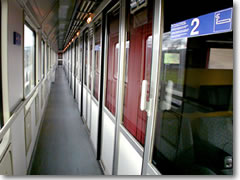Not getting railroaded: Train safety in Europe
Sleeping on overnights trains in Europe is a relatively safe endeavor, but take a few sensible precautions to avoid pickpockets and thieves and sleep more soundly

Anyone can wander the aisles of European trains. Your best and most effective defense against itinerant thieves is simply to make sure you lock the door between your compartment and the public corridor at night.
Couchette doors lock from the inside and can only be unlocked from the outside by a special key the conductor carries. This next bit should be obvious, but: always lock your door.
Feel free to underscore the importance of this to your fellow couchette buddies even if you have to pantomime it so that if they get up in the middle of the night to visit the bathroom down the corridor, they'll remember to lock up when they re-enter.
Remember: You're sharing a room with up to five strangers, so don't flash anything valuable. You should be fine. After 20 years and many, many overnight train rides, I witnessed my first robbery only a few years ago.
While we were both sleeping, the stranger who shared my couchette had his bag stolen from where it was hanging next to his head in the middle bunk. The door was unlocked when I awoke, but neither he nor I nor the conductor could figure out how it happened, unless the victim unlocked it in the middle of the night to nip out to the bathroom, forgotten to relock it, and was now stonewalling to cover his shame (or simple bleary forgetfulness).
I, however, felt secure because I had reserved the top bunk—which gets much hotter than the lower bunks, but puts you out of all but the tallest thief's reach. It allows you to sleep with your head right next to your bags, which are stowed in a niche above the door. I had strapped my pack to the niche's guardrail, so that no one could simply tug it down and run off.
Sure, I spent an extra minute the next morning extracting my bag from its cranny, but two of us walked out of that couchette, and only one of us still had his stuff.
The main rules
Don’t flash your valuables. You’re sharing a couchette with strangers. My philosophy is one of pragmatic optimism: always assume the best of other people...but prepare for the worst.
Make sure the door is locked and that everyone in the couchette understands the importance of keeping it locked (the conductor usually emphasizes this, but be a nerd and do it yourself, too).
Reserve the top bunk. It’s a hotter ride (heat rises), but it puts you above most thieves’ easy reach, plus you can sleep with your head right next to your bags.
Stow your bags in the luggage niche above the door. There’s a little guardrail to keep them from sliding out; strap or lock your bags to this rail so a thief can’t tug them down and run off. He won’t work at it if he can’t get them easily.
Wear your money belt while you sleep. Do not take it off. After you’ve taken care of tickets and passports with the conductor, you may want to excuse yourself to the bathroom and strap that waistbelt around your upper thigh instead. This sounds creepy, but thieves with light touches do sometimes unzip your pants and deftly empty the money belt while it’s still on your sleeping person—but if it’s around your thigh, there’s no way they can get to it without you noticing.
You might want to make a pillow out of your valuables. It’s not the most comfortable way to sleep, but if you wrap things in your sweater and poke it in a stuff sack, it may be soft enough to lay your head on.
Be especially careful sleeping in unreserved sitting couchettes, where there are no locks on the doors.
Most train stations are fairly safe, but because they are central clearinghouses for bewildered tourists overwhelmed by a new city and probably not paying close attention to what's going on around them, pickpockets abound. Be careful, never abandon your bags, and don't be distracted by all the hotel touts who will swarm you offering rooms.
Related Articles |
Outside Resources |
This article was last updated in October 2006. All information was accurate at the time.
Copyright © 1998–2010 by Reid Bramblett. Author: Reid Bramblett.

